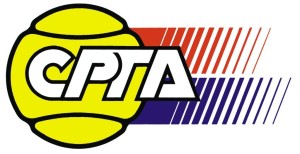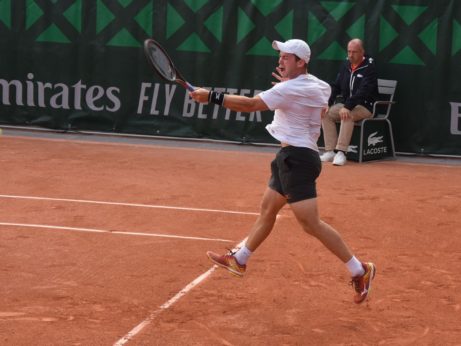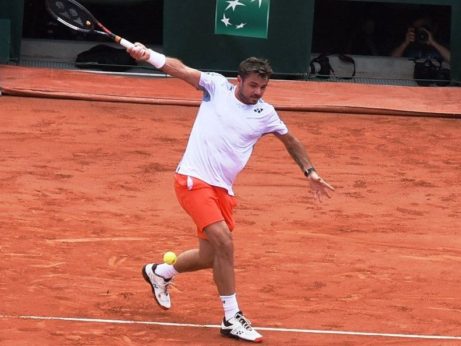Roger Federer – Secrets of his Service 3.0
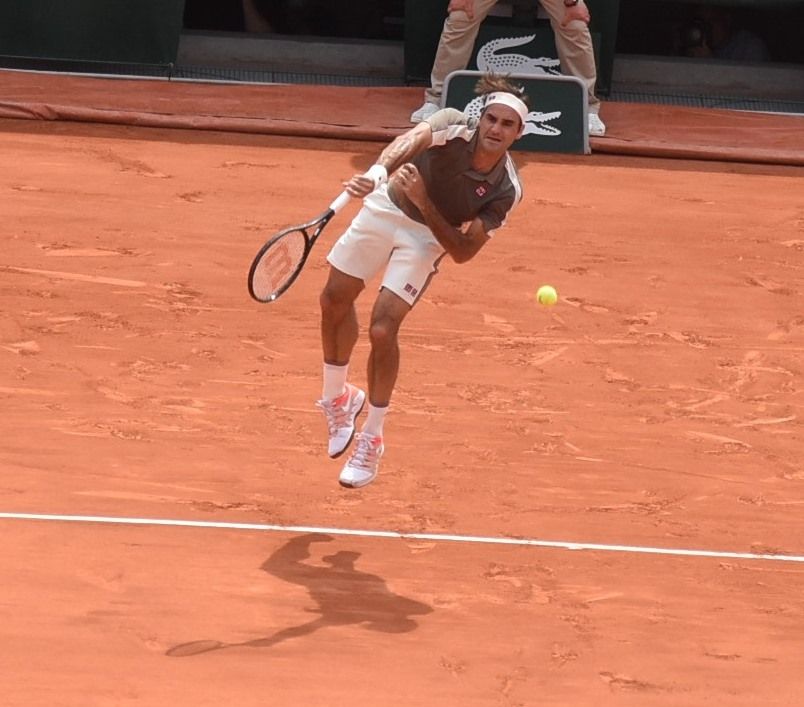
The living legend of the tennis sport, after over 20 years in the hard professional tennis business still very successful at the top-level of the competition, and also the greatest modern-time ambassador of his native Switzerland, Roger Federer (*81 / SUI) has been very often admired for his nearly perfect tennis stroke technique. The almost seamless and effortless efficiency of his strokes is then not only one of the fundaments of Roger’s enormous success but also one of the reasons why he was physically able to stay on the tour for such a long time and without any bigger health problems.
Besides the very powerful and also highly variable Forehand 3.0, service is Roger’s biggest weapon. His Service 3.0 is an almost ideal stroke with a high level of the dynamic racket stability in the space, thanks (also) to the underlying helix (3-D) stroke form. The almost all-deciding principal outcome effect is the (in most cases) nearly perfect body energy unloading against the target while canalized into a well-controlled (targeted) long-axis pronation.
The photos below show that, in a contrary to the rather dangerous coaching myths about the necessity to swing the racket by the non-dominant (here left) leg, as preached for decades in most of the tennis books and by most of the tennis coaches, Roger stays with his racket for a very long time on the dominant (right) side where he also unloads the biggest portion of the previously developed energy during the “follow-through 1”. He has further improved this aspect of his service in the Spring of 2009 when he started to pay even more attention to keeping the entire unloading action in one axis oriented against the target. Only when the struck ball is nearing the net, Roger’s racket goes rather slowly, and without any significant energy involved, across (to the left leg). This low-energy “follow-through 2” has to be considered merely as a relaxation. These here above-mentioned unloading aspects, together with a practically ideal backswing (takeback), a well-controlled outside-inside loop toss and a massive push-off are then some of the principal elements of the “Tennis 3.0 Code” making Roger’s Service 3.0 to such an efficient weapon.
Needless to say, Roger has also one potential weakness in his otherwise amazing service. It’s the bending (flexion) in the hip area combined with the sometimes a bit excessive knee bend during or slowly after the impact. Based on the extent and timing of these bendings, they may lead to a reduction of the available energy. In general, when Roger bends during the service motion in the hip area too early and too excessively, his service loses mainly some of the energy and thus some of the speed. Such service then tends to be rather shorter and lands rather too far from the service box lines. It appears that the mentioned bendings are a bit more excessive while serving from the ad side. This was quite often the case during the 2019 French Open and also in the match against Stan Wawrinka (SUI) there. The below-shown photos from this match showcase the problem. The question here is, if certain Roger’s low-back problems are the main reason for this bending or if the bending (in my opinion, partly connected with the massive push-off and actually positive, when not too excessive) did lead to these (mainly) low-back problems.
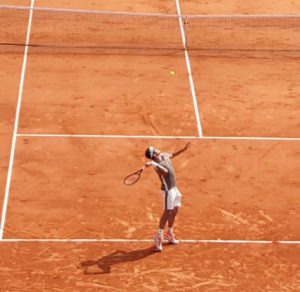
Roger Federer (*81 / SUI) – 1st service 3.0 in a match – 1 of 8 – ad side – push-off / getting into the cocking position – the back (right) foot drags from the platform stance, in which the push-off initiated, to a nearly pinpoint stance, the ball, being tossed on a moderate outside-inside loop, is slightly on the outside (right) of the hitting shoulder, perfect eye control of the impact zone – 2019 French Open – Paris / France – June 2019
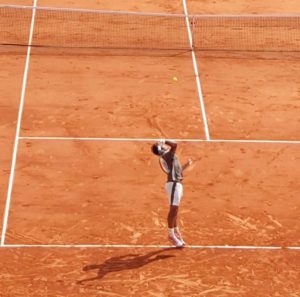
Roger Federer (*81 / SUI) – 1st service 3.0 in a match – 2 of 8 – ad side – push-off – end – racket acceleration from the cocking position is starting – the racket is well in-line and fully integrated into the targeted unloading of a helix form, also perfect control of the head/eyes position and of the non-dominant (left) arm – 2019 French Open – Paris / France – June 2019

Roger Federer (*81 / SUI) – 1st service 3.0 in a match – 3 of 8 – ad side – shortly after the impact – still with a perfect control of the non-dominant (left) arm, the bendings in the hip area and in the knees are well-visible here, this service was then also rather quite short – 2019 French Open – Paris / France – June 2019

Roger Federer (*81 / SUI) – 1st service 3.0 in a match – 4 of 8 – ad side – follow-through 1 aka guided unloading over a perfectly targeted long-axis pronation where the racket travels on the outside (right) of the ball trajectory – 2019 French Open – Paris / France – June 2019
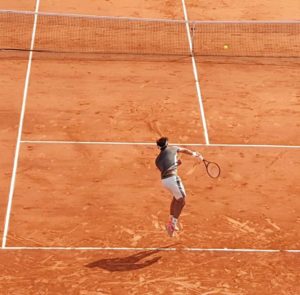
Roger Federer (*81 / SUI) – 1st service 3.0 in a match – 5 of 8 – ad side – follow-through 1 / unloading – continuation – most of the previously developed energy is being precisely spent (unloaded) into the direction of the intended target or rather slightly more outside (here right) of the flight trajectory of the struck ball, the high-level precision in the unloading is still being supported by the perfect head/eye and non-dominant (left) arm control – 2019 French Open – Paris / France – June 2019

Roger Federer (*81 / SUI) – 1st service 3.0 in a match – 6 of 8 – ad side – follow through 1 – end – most of the available energy was spent already, but the racket still stays of the dominant (right) side and the palm keeps pointing to the outside, Roger is also still “in the air” – 2019 French Open – Paris / France – June 2019

Roger Federer (*81 / SUI) – 1st service 3.0 in a match – 7 of 8 – ad side – follow-through 2 aka relaxation starts – the fact that Roger is still “in the air” while the struck ball crosses the net documents how massive his push-off really is – 2019 French Open – Paris / France – June 2019

Roger Federer (*81 / SUI) – 1st service 3.0 in a match – 8 of 8 – ad side – follow-through 2 – continuation – the ball has crossed the net, but Roger has not landed in the court yet – 2019 French Open – Paris / France – June 2019

Roger Federer (*81 / SUI) – 1st service 3.0 in a match – 1 of 7 – deuce side – start – relaxed concentration – weight is on the front (left) foot at this moment – 2019 French Open – Paris / France – June 2019

Roger Federer (*81 / SUI) – 1st service 3.0 in a match – 2 of 7 – deuce side – toss/takeback – tossing arm is perfectly controlled, ball release will happen above shoulder level – 2019 French Open – Paris / France – June 2019

Roger Federer (*81 / SUI) – 1st service 3.0 in a match – 3 of 7 – deuce side – toss/loading – massive knee bend in the platform stance, the tossing arm follows an outside-inside arch and so does the tossed ball – 2019 French Open – Paris / France – June 2019
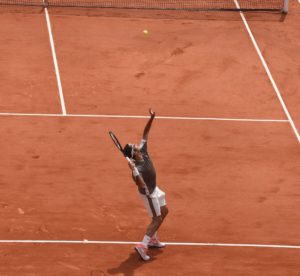
Roger Federer (*81 / SUI) – 1st service 3.0 in a match – 4 of 7 – push-off 1 – perfect head/eye and non-dominant (left) arm stability – 2019 French Open – Paris / France – June 2019
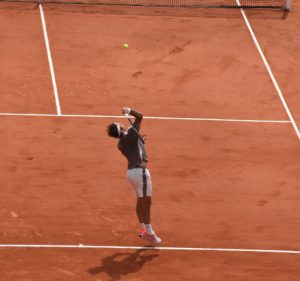
Roger Federer (*81 / SUI) – 1st service 3.0 in a match – 5 of 7 – deuce side – acceleration from the cocking position dominated by the high elbow and perfect eye control of the impact zone, the axis of the racket is in-line with the intended target – 2019 French Open – Paris / France – June 2019

Roger Federer (*81 / SUI) – 1st service 3.0 in a match – 6 of 7 – deuce side – follow-through 1 / unloading – most of the previously developed energy is being precisely spent (unloaded) into the direction of the intended target and later rather quite significantly more outside (here right) of the flight trajectory of the struck ball, the high level of the precision in the unloading is still being supported by the perfect head/eyes and non-dominant (left) arm stability – 2019 French Open – Paris / France – June 2019

Roger Federer (*81 / SUI) – 1st service 3.0 in a match – 7 of 7 – deuce side – landing/follow through 2 aka relaxation – 2019 French Open – Paris / France – June 2019

Roger Federer (*81 / SUI) – 1st service 3.0 in a match – 1 of 1 – deuce side – follow-through 1 / unloading – most of the previously developed energy is being precisely spent (unloaded) into the direction of the intended target and later (as shown here) rather quite significantly more outside (here right) of the flight trajectory of the struck ball, the high level of the precision in the unloading is still being supported by the perfect head/eyes and non-dominant (left) arm control – 2019 French Open – Paris / France – June 2019

Roger Federer (*1981 / SUI) – 1st service 3.0 in a match – 1 of 4 – deuce side – push-off – racket accelerates from the cocking position, perfect eye control of the impact zone (as the elbow didn’t rise ideally here, the thus resulting lower stroke trajectory caused an error) – 2018 Wimbledon Championships – London / UK – July 2018

Roger Federer (*1981 / SUI) – 1st service 3.0 in a match – 2 of 4 – deuce side – follow through 1 – body energy unloading into a targeted long-axis pronation – 2018 Wimbledon Championships – London / UK – July 2018

Roger Federer (*1981 / SUI) – 1st service 3.0 in a match – 3 of 4 – deuce side – follow through 2 aka relaxation, the racket is very calm – 2018 Wimbledon Championships – London / UK – July 2018
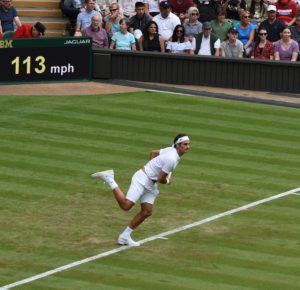
Roger Federer (*1981 / SUI) – 1st service 3.0 in a match – 4 of 4 – deuce side – landing – perfect eye control of the other side of the court (113 mph indicated the speed of the previous 2nd service) – 2018 Wimbledon Championships – London / UK – July 2018
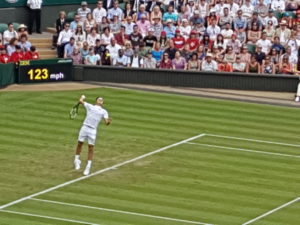
Roger Federer (*1981 / SUI) – 1st service 3.0 in a match – 1 of 5 – deuce side – push-off – racket accelerates from the cocking position – 2018 Wimbledon Championships – London / UK – July 2018
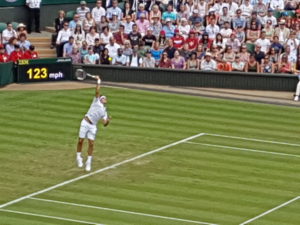
Roger Federer (*1981 / SUI) – 1st service 3.0 in a match – 2 of 5 – deuce side – racket is nearing the impact, head/eyes are looking up towards the ball/target zone – 2018 Wimbledon Championships – London / UK – July 2018
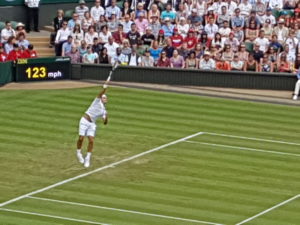
Roger Federer (*1981 / SUI) – 1st service 3.0 in a match – 3 of 5 – deuce side – impact with an almost ideal extension – 2018 Wimbledon Championships – London / UK – July 2018

Roger Federer (*1981 / SUI) – 1st service 3.0 in a match – 4 of 5 – deuce side – follow through 1 – perfect body energy unloading into the targeted long-axis pronation – 2018 Wimbledon Championships – London / UK – July 2018
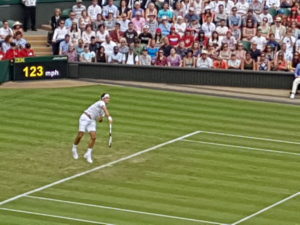
Roger Federer (*1981 / SUI) – 1st service 3.0 in a match – 5 of 5 – deuce side – follow through 1 – end – the ball is far gone, but Roger is still in the air and the racket remains on the dominant (right) side – 2018 Wimbledon Championships – London / UK – July 2018
This article covers certain aspects of Roger Federer’s service and service in general only! Further very extensive photo galleries and more distinct details about his service and other strokes as well as about the strokes of other players are available upon a qualified request at drmgb11(at)gmail.com. Some significant details of this kind, necessary for the peak performance in modern tennis as well as for a sustainable tennis training/development in general, are being discussed also in the seminar “TENNIS 3.0 – Future of the Game”, which is available worldwide upon request – www.tennis30.com / www.tennis30.cz
Photos (July 2018 & June 2019) & text (September 2019) copyright by Dr. Martin G. Baroch. Any further publication of either any of the photos and/or texts with the explicit written permission issued by the author/copyright owner only!! All instruction provided reflects just the personal opinion of the author and neither the author nor the CPTA accepts any responsibility for potential damages, direct or implied, of any kind!!
